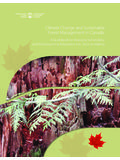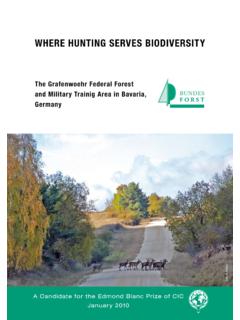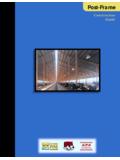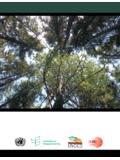Transcription of Forest fire risk assessment and cartography - A ...
1 Forest fire risk assessment and cartography - A methodologicalapproachRapha le Blanchi cole des Mines de ParisBP207, 06904 Sophia Antipolis CedexTel : , Fax : : JappiotCemagref, Groupement d Aix-en-ProvenceLe Tholonet, BP 31, 13612 Aix en Provence Cedex 1 Tel : , Fax : : AlexandrianAgence MTDA238 avenue du Club Hippique, 13090 Aix en ProvenceTel : , Fax : : prevention of Forest fire, risk assessment , cartography , risk definitionABSTRACT: The difficulties to know the risk and the diversity of the needs led us to study andclarify hazard assessment .
2 The objective of the study, presented in this paper, is to clarify theconcepts relating to the risk, to appreciate the multiplicity of the existing needs, to analyze themeans of risk assessment and to identify the data currently usable, as well as the processing andthe information systems available. Two steps have been developed: a state of the art and a meth-odological INTRODUCTIONF orest fires is part of the ecosystem, but it becomes a risk when by its frequency or its intensity, itdestroys the Forest beyond what is admitted and threatens men and their activities.
3 Forest fire riskhas increased during the 20th century with the socio-economical change of our society (situation inthe south of France, but available also in the Mediterranean basin). The evolution of landuse andthe decrease of agricultural activity led to more Forest fuel and to the multiplication of urban areasin contact with natural Forest areas. These wildland/urban interfaces are all the more vulnerable tofire than man is responsible for fire departures. It becomes necessary to manage these areas withprevention , any prevention policy is initially based on risk assessment and mapping that requiresto produce knowledge on the phenomenon and its damaging consequences.
4 But the study andanalysis of risk (particularly in the field of Forest fires) include difficulties linked to the complexityof the identify and localize the hazard, various methods can be implemented. Those vary accordingto the aims, the means and the various forms of modeling used. The methods taken into account inthis paper deal with long-term hazard assessment at various scales in opposition with daily hazardestimation for operational purpose. At the present time different methods are available. The studiesconducted on these topics are up to date and diverse, for example: comparative study of the risklevels in the administrative units of the European Union states, study of the fire hazard in a district(for a legal purpose), study of ignition hazard along roads in order to complete the preventivemaintenance.
5 This diversity shows a wide variety of difficulties to know the risk and the diversity of the needs led us to study and clarify hazardassessment. The objective of the study, presented in this paper, is to clarify the concepts relating tothe risk, to appreciate the multiplicity of the existing needs, to analyze the means of risk assessmentand to identify the data currently usable, as well as the processing and the information systemsavailable. Two steps have been developed: a state of the art and a methodological A STATE OF THE ART BASED ON THREE QUALITATIVE APPROACHEST hese approaches showed below aim at collecting and condensing information to clarify the char-acteristics of the existing hazard assessment Conduction of a surveyThe objective is to determine the hazard knowledge, the evaluation needs, the methods by differentpeople involved in risk first methodological step is based on an investigation with risk cartography users.
6 Theobjective is to determine the risk perception, the needs for assessment , the cartography methodsshared by this people. The people constituting the sample answer various criteria. We look forrepresentativeness in scales (from Europe to the city scale), various types of users (public or pri-vate) and concerns (from prevention to the fight).People were contacted by telephone or by mail. We should then underline certain skews of ourapproach. The conditions in which the talks were made are not always the same, which involves aheterogeneity of the sources of is thus difficult to compare the answers given.
7 Nevertheless, these talks contributed to char-acterize, in the broad outline, knowledge and the needs for risk To collect existing methodsWe collect the studies done on risk assessment in different organisms and locations (administration,research laboratories, ..). However, it should be stressed that the sample is not quantitatively rep-resentative of what exists: we eliminate some similar studies, only some were taken into fifty studies concerning risk assessment were mapping have less than twenty years. Previously, they were rather "descriptive" ap-proaches such as:- the history of the last events,- types of vegetation (inflammability, combustibility),- the inventory of fire ignition 1 : Development of fire risks studies (fifty studies have been collected)Starting from the end of the Eighties, the concept of risk started to be integrated in manage-ment plans of the Forest .
8 This way of taking into account the risk was done with very basic ele-ment, very often using a simple map of vegetation. This kind of approach did not completely dis-appear today (in particular for certain kind of departmental or regional approaches).There is an increasing of studies since the beginning of the Nineties. We attend a change, thestudies deal with wildland/urban interfaces (few works were conducted on this topic). Nowadays,when the concept of risk is taken into account in prevention plans (for urban planning), the meth-ods employed "are in general more sophisticated", the authors seeking to synthesize several lay-ers of information by using a To set up a tool to analyze these studiesThe last methodological approach has the aim of analyzing the existing methods of risk make a distinction between these studies which have different objectives, a grid of analysis hasbeen implemented which leads to inventory and study in depth the methods.
9 This one allows a sim-plified and homogeneous reading of each technique of analysis leads to inventory and study in detail the methods employed in or-der to define and evaluate the risk, by considering several aspects. Thus the grid of analysismakes possible to appreciate the knowledge of risk concept which the authors of the studies the limits are the same ones as those mentioned previously, the sample does notmake it possible to give an account of a homogeneous unit. Information resulting from this analy-sis is thus to use with precaution.
10 The results enable us, however, to present the main current ten-dencies of risk main aspects taken into account in the grid was :- Analyze of needsGeneral aspects (spatial, scales, ..)Objective of the study- Analyze of methods set upDescription (definition of risk, parameters taken into account, perimeter of studies, scales)Risk assessment ( approach , models, tools, validation)- Description of the data (kind of data, origin, timelessness)0510152025301970-19741975-1 9791980-19841985-19891990-19941995-19993 methodological APPROACHThe results drawn from this analysis had led us to develop a methodological process in order to as-sess and map Forest fire hazard.







